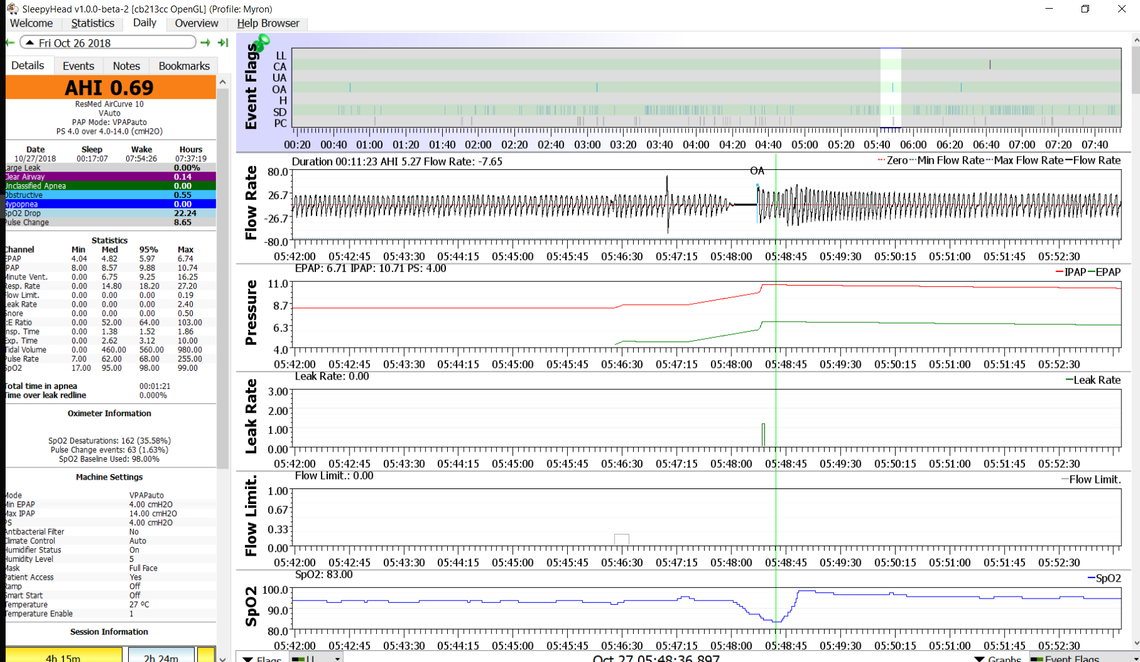I'm on ResMed AirCurve. EPAP 4, IPAP 8, PS 4. Maximum IPAP 14. My last sleep test showed I did good almost all night at 8/4 and 9/5 maximum pressures. But my other sleep test earlier this year, the doctor recommended 14/10 PS 4, but he never set my machine to that. He only set it to Auto range starting lower.
Ever since I started my CPAP/BIPAP, my Oxygen level will drop to the low 80's for a short time. 30sec or so. One time it was 78%. I bought myself a Contec SpO2 monitor that records overnight. It correlates low oxygen drops with my apneas.
My question is, is it normal to get into 80%'s during such short 20-45 second apneas? My doctor doesnt seem concerned. I am concerned, which is why i bought the O2 monitor, which has an alarm to wake me up when it hits 84%. It routinely alarms me a couple times a night or more waking me up.
I'm not so sure 20-40 second apnea events are that short. My central events seem to range from 10-17 seconds, and the obstructive ones 10-20 seconds. I don't monitor O2, so not sure what impact it has. What are your AHI values like? Assuming your 02 meter is compatible with SleepyHead, I believe it has the ability to integrate the O2 values in with the other data so you can see what they are related to.

I have a Contec SpO2 monitor that i wear on my wrist. It records all night long. I'll post some charts of a good night and bad night. What is concerning, is that on my "bad" nights, I'll have a LOT of obstructions in a row. Yet my O2 doesn't drop very low. Maybe 90%. But then on a "good" night, I'll have a 20sec that drops it to the 80's which is weird. My AHI is most of the time is low. AHI < 2. Other times it goes up over AHI 7+. I'm trying to keep my AHI down, because I have AFIB, and when I get a lot of obstructions in a row, it has caused my heart to go into abnormal rhythm.
I am now on my second sleep doctor. Previous doctor had me only on APAP which didn't work well. My current sleep doctor at least got me a BIPAP which works better. But...he is not very thorough in looking into sleep problems. He looks at the 30-60 day summary and says my average is good. He refuses to analyze the nights where I have a LOT of obstructions.
So I started to set my own pressures, and bumping up the maximum. But my machine kept hitting the maximum as seen in the image below. But the doctor came back and reset my pressures, and said that I do better on "lower pressures" and with PS 4. I don't see how that is possible? He even lowered my maximum, as seen in the second picture. Also if I have any type of leaks, my night will be terrible. I've woken up with major palpitations, tachycardia, night sweats, and my left side of chest quivers bad like my heart took a pounding all night long.
Here is a "bad" night. Notice all the obstructions in a row. I'm not sure why that is, since I also use a ResMed Narval Dental Appliance to move my jaw/tongue forward.

Here is a good night, but my O2 dropped to 80's during a single event.

Those are very interesting charts. I've looked at a lot of different charts, but have not seen one like your first one before. You don't seem to suffer from any significant central apnea, but those periodic flow rates sure look a lot like a periodic breathing pattern that can be caused by breathing control system issues. They usually lead to high CA frequency not OA though. Your second chart looks very normal, other than the dip in O2 level which does seem a little out of proportion to the apnea event.
My first thought, is that your pressure support may not be doing you any good. In the first chart most of the time the pressure is maxed out at 15 cm IPAP, and with the 3 cm of pressure support, EPAP maxes out at 12 cm. Obstructive apnea is just as likely or more likely to occur during EPAP compared to IPAP. This means your effective treatment pressure is really being limited to 12 cm. If you are comfortable with making your own adjustments, I think the first thing I would try is setting the pressure support to zero and the max min pressure to say 15 cm and 8 cm respectively. That should allow the EPAP to go up as high as 15 cm. Maximum IPAP will not be increased above the 15 cm. You may see a significant improvement in obstructive apnea frequency with the higher EPAP pressure. Once you find out what pressure works you may be able to lower the maximum, and increase the minimum to get even better results.
The other thing you might consider is a soft cervical collar. Some people seem to suffer from positional issues that cause high frequency obstructive events only when they are in a certain neck position. The collar can help avoid that positional issue. I have not used one, so cannot offer any personal testimonial, but it does make some sense.
Hope that helps. If I can find something more about that odd flow rate pattern I will post again. You also may want to try and squeeze the snore chart on the screen. It often can give an indication of pending obstructive events.